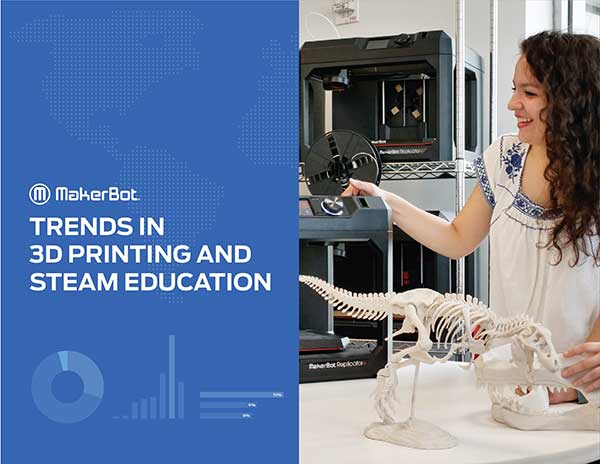MakerBot has released its latest report, “Trends in 3D Printing and STEAM Education.” Based on over 1,000 responses from education professionals around the world, the report illustrates the use of 3D printing in education and how it is applied across grade levels among respondents.
Key findings from the report reveal that 63% of respondents use 3D printing to better prepare their students for the workforce, but they want more than just a 3D printer to be successful—respondents want a full ecosystem of 3D printing resources to achieve their educational goals. A total of 65% of respondents cited that online training programs would help them to implement the technology better, while 63% and 56% of respondents also cited lesson plans and educational webinars as useful 3D printing resources, respectively.
“We are at a pivotal moment in education,” says Nadav Goshen, CEO of MakerBot. “We have seen the use of 3D printing in education increase steadily over the past years due, in part, to the availability of more products and services geared toward teachers and students. Affordable and easy-to-use 3D printers, training and certification programs, integrated lesson plans, and online 3D printing resources have made the technology attractive to many educational institutions. In addition, working with 3D printers can help students develop practical and usable skills that can be used outside of the classroom.”
Additional key findings from the Trends in 3D Printing and STEAM Education report include:
Authentic learning experiences are becoming a popular new teaching method. Design-based learning (57%), integrated learning (51%) and collaborative learning (49%) were identified as the top teaching methods among respondents. Only 42% of respondents stated that they still use traditional learning settings with students.
Teaching STEAM subjects requires resources that schools may not have. Budget constraints (56%), insufficient equipment (45%) and lack of technical training (39%) were cited as the top challenges to teaching STEAM subjects.
3D printing is widely used to develop practical skills that can be used beyond the classroom. Respondents cited developing problem-solving skills (63%), skill sets for future careers (63%) and creative thinking skills (63%) as their top reasons for 3D printing adoption.
Educators want more than just a 3D printer. They want a full 3D printing ecosystem. A whopping 82% of respondents cited 3D printing resources (i.e., lesson plans, training programs, etc.) as important factors when choosing a 3D printer.
Costs, reliability and ease of use play important roles in decision-making. A whole 95% of respondents rated reliability as an important benefit, while 90% said ease of use was important and 89% said costs were important.
“The importance of 3D printing in education cannot be overstated. The report revealed the shift from traditional learning environments to more interactive and engaging approaches. By teaching visualization, design and creation via 3D printing, 3D printing opens up opportunities for students and brings ideas to life,” adds Goshen.
About the Study
MakerBot surveyed over 1,000 education professionals who are in its global network, Aug. 21-26, 2020. Respondents were based in North America (60%), Asia (15%), Europe (14%), South America (8%), Oceania (2%) and Africa (2%). They teach a range of disciplines, including 3D printing, art & design, mathematics, engineering, language studies, history and more.
For the full report, visit https://pages.makerbot.com/edu3DPrintingTrendReport.html.
About the Author
Press releases may be sent to them via [email protected]. Follow Robotics 24/7 on Facebook
Follow Robotics 24/7 on Linkedin
Article topics
Email Sign Up
















